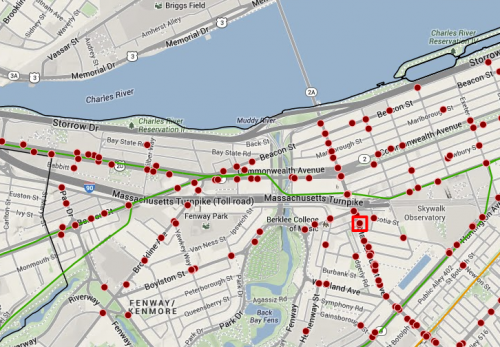Boston Area Research Initiative Releases Crash Data Map
Written by Boston Biker on Jun 19From the Boston Cyclists Union:
The Boston Area Research Initiative (BARI), the Boston Cyclists Union, the Boston Police Department and other partners, led by Rappaport Fellow Dahianna Lopez, have released two new tools for bike advocates everywhere. One is aninteractive online crash map that allows people to identify crash clusters and see potential patterns. Two is a public release of the raw data that helped create that map. The raw data however contains much more data than the map—including narrative police reports that are our best indication of cause and a number of facts derived from them.
The release of the data opens the door for researchers around the world and allows Boston to join just a handful of cities in the country that provide public access to police crash data, and a very select few that include narrative police reports with that data. Accessing the data requires a LinkedIn profile and approval by BARI.
More from BARI:
This instance of BostonMap illustrates patterns in bicycle collisions across Boston, MA between 2009 and 2012. The data are derived from Boston Police Department (BPD) incident narrative reports, as organized and compiled by Dahianna Lopez (Harvard Injury Control and Research Center) and partners at BPD, BARI and the Boston Cyclists Union. Visitors can also download the raw data, including narrative reports, and documentation at the BARI Data Library.
The Boston Research Map
Boston Research Map is an open source web mapping system that is an ongoing project of the Boston Area Research Initiative (BARI) in conjunction with the WorldMap team. It is intended to help faculty and their students, policymakers and practitioners, and community members to explore the neighborhoods of Boston from their computer. Visitors to BostonMap can:1. Interact with the best available public data for the Boston region, while also uploading their own data.
2. See the whole Boston area but also zoom in to particular places.
3. Accumulate both contemporary and historical data supplied by researchers and make it permanently accessible online.
4. Work collaboratively across disciplines and organizations with spatial information in an online environment.
Check out the map here
The obvious benefit of data like this is that it allows a glance to see the “hot zones” of bicycle crash areas. Its obvious that Huntington Ave. and Mass. Ave. are where most of the crashes happen, and that should be where most of the effort is put to reduce them.
I was also not surprised to see that there are many crashes on the green-way bicycle path in JP. After having spent years riding on that path I can tell you that it is deceptively dangerous and could use some serious upgrades/safety changes. I wouldn’t mind seeing the existing bike path given over to pedestrians (they basically use it like a walking path anyway, even though there are signs telling them every 100 feet not to). With the current sidewalk could be turned into a buffered cycle track with a permanent cement buffer. This would keep cyclists out where turning cars can easily see them.
Big data can lead to safety, but there are some drawbacks to these maps. They need context, it would be super helpful if I could easily sort by deaths, minor skinned knee, car caused, cyclist causes, pot holes, etc. To a non-cyclist looking at this map might scare them rather badly about the safety of cycling. These issues are easy enough to solve, the data simply must be segmented properly.
Overall, these sort of projects are amazing and I can’t wait to see more of them. The next step might be a smart phone app that can help cyclists donate anonymous data to a project like this. Keep up the good work BARI, and I look forward to data like this driving future planning and policy choices.
Tags: bari, big data, boston cyclists union, maps
Posted in advocacy, infrastructure | Comments Off on Boston Area Research Initiative Releases Crash Data Map






Sorry, comments for this entry are closed at this time.